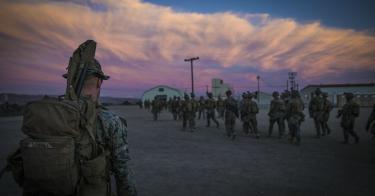Shortly after becoming the U.S. Marine Corps’ 38th commandant in July, Gen. David Berger announced his plan for the future of the Marine Corps. His strategies align with ideas recommended by Dakota Wood, a senior research fellow in The Heritage Foundation’s Davis Institute for National Security and Foreign Policy.
Wood, who served for two decades in the Marine Corps, outlined his recommendations in a May special report for Heritage, “Rebuilding America’s Military: The United States Marine Corps.”
“What this shows is that The Heritage Foundation clearly understands the Marine Corps and the challenges facing them,” Wood says. “To the extent the Marine Corps uses that understanding, it is valuable.”
Wood’s report, the first service paper in the Rebuilding America’s Military Project (RAMP) series, makes the case for increased experimentation within the Marine Corps to prepare for the specific warfare conditions that are most likely to arise in the immediate future. Such experiments might suggest different ways of conducting amphibious operations.
Wood suggests that though the Marine Corps’ increased ground capabilities and special operations forces have been useful in fighting the war on terror, the Corps must return its focus to its original purpose as a sea-to-land force, especially as the Indo-Pacific region becomes increasingly important to U.S. grand strategy.
Berger announced five priorities in his Commandant’s Planning Guide: force design, warfighting, education and training, core values, and command and leadership. In the past, the Marine Corps has expressed its desire to invest more in naval operations, but so far has not implemented those changes across the Corps.
Berger emphasized that re-integration of the Navy and the Marine Corps is “an imperative.”
“Navy and Marine Corps officers developed a tendency to view their operational responsibilities as separate and distinct, rather than intertwined,” Berger’s plan states. “With the rise of both land and sea-based threats to the global commons, there is a need to re-establish a more integrated approach to operations in the maritime domain.”
Because future naval campaigns will likely include the littoral waters in the Indo-Pacific region, the Corps needs the ability to create “flatter” combat formations, which do not necessarily fit into the Marine Corps’ traditional Marine Air Ground Task Force model, Wood explained.
Berger’s plan affirmed this.
“We are not defined by any particular organizing construct—the Marine Air Ground Task Force (MAGTF) cannot be our only solution for all crises,” Berger wrote. “Instead, we are defined by our collective character as Marines and by fulfilling our service roles and functions prescribed by Congress.”
As modern warfare continues to change in scope and shape, Wood stressed the necessity of the Marine Corps to pioneer not merely innovative hardware, but new methods of troop organization, experimenting incrementally.
Berger also listed modernizing the Corps as one of his key warfighting priorities, specifically by distributed operations.
“New threats, new missions, and new technologies require us to adjust our organizational design and modernize our capabilities,” Berger’s plan states. “While others may wait for a clearer picture of the future operating environment, we will focus our efforts on driving change and influencing future operating environment outcomes.”
